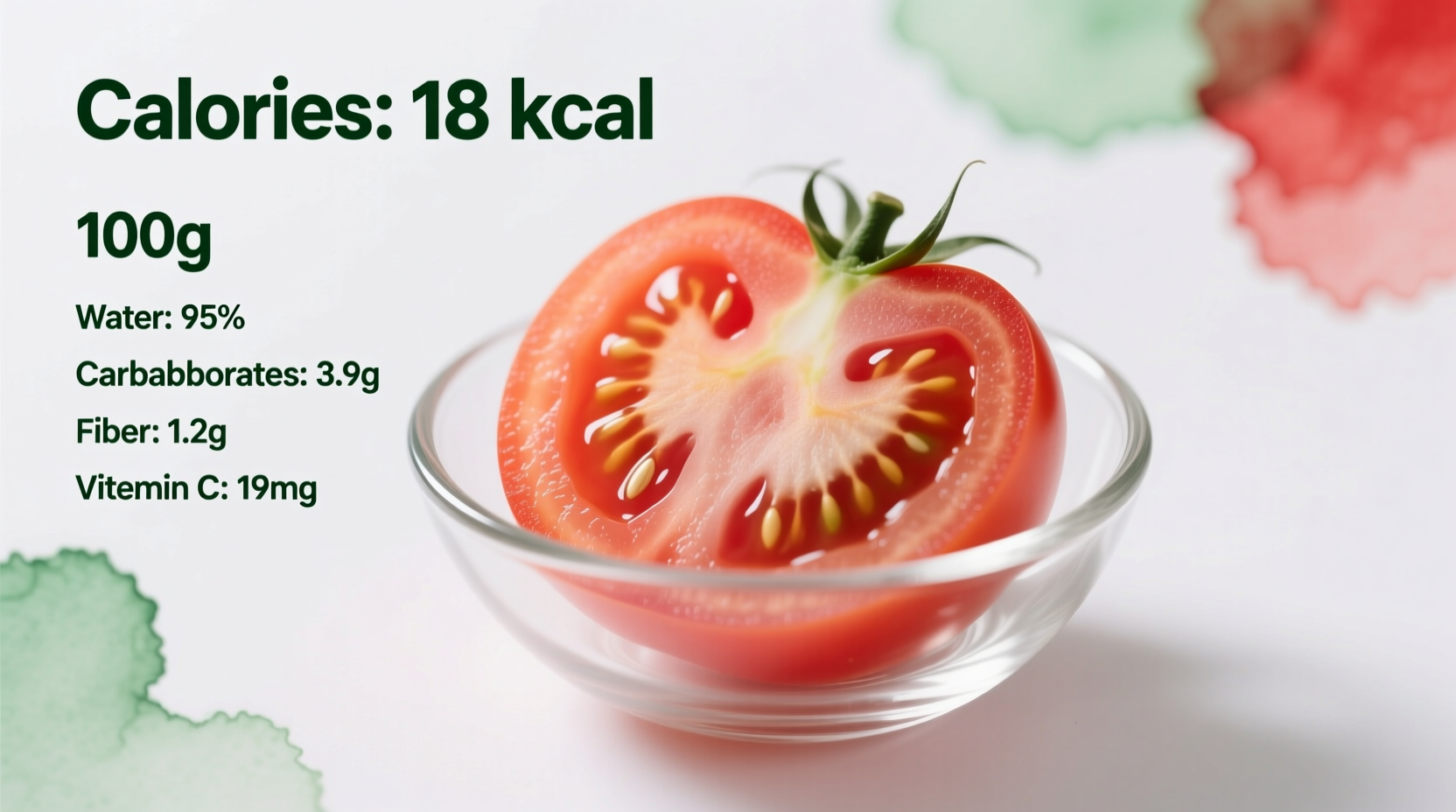100g of raw tomatoes contains exactly 18 calories according to the USDA FoodData Central database. This low-calorie count makes tomatoes an excellent choice for weight management and healthy eating plans while providing essential vitamins and minerals.
Understanding the precise nutritional value of everyday foods helps you make informed dietary choices. Whether you're tracking calories for weight management, meal planning, or simply curious about what you're eating, knowing the exact calorie content of tomatoes provides valuable context for your nutritional decisions.
Complete Nutritional Profile of Tomatoes
Tomatoes offer far more than just low calories—they're packed with essential nutrients that contribute to overall health. The USDA's comprehensive analysis reveals exactly what you get in every 100g serving of raw tomatoes:
| Nutrient | Amount per 100g | % Daily Value* |
|---|---|---|
| Calories | 18 kcal | 1% |
| Total Fat | 0.2g | 0% |
| Carbohydrates | 3.9g | 1% |
| Dietary Fiber | 1.2g | 4% |
| Sugars | 2.6g | - |
| Protein | 0.9g | 2% |
| Vitamin C | 14mg | 16% |
| Vitamin A | 833 IU | 17% |
| Potassium | 237mg | 7% |
| Lycopene | 2573μg | - |
*Percent Daily Values are based on a 2,000 calorie diet. Your daily values may be higher or lower depending on your calorie needs.
How Tomato Calories Fit Into Your Daily Nutrition
With just 18 calories per 100g, tomatoes represent less than 1% of a standard 2,000-calorie daily intake. This makes them an exceptionally nutrient-dense food—providing significant vitamins and minerals with minimal caloric impact. A medium-sized tomato (approximately 123g) contains only 22 calories while delivering 28% of your daily vitamin C needs and 22% of vitamin A.
The low energy density of tomatoes makes them particularly valuable for weight management strategies. Research published in the Journal of Nutrition demonstrates that foods with high water content and low calorie density, like tomatoes, help increase satiety while reducing overall calorie intake.
Tomato Varieties and Calorie Differences
While the standard raw tomato contains 18 calories per 100g, different varieties show slight variations:
- Roma tomatoes: 21 calories per 100g (slightly higher sugar content)
- Cherry tomatoes: 18 calories per 100g (similar to standard)
- Beefsteak tomatoes: 16 calories per 100g (higher water content)
- Cooked tomatoes: 26 calories per 100g (concentrated through water loss)
These minor differences won't significantly impact your daily calorie count, but they're worth noting if you're tracking nutrition precisely. The USDA has maintained consistent measurement standards for tomato nutrition since 2012, with data verified through their FoodData Central database.
Tomatoes in Practical Meal Planning
Understanding tomato calories becomes particularly valuable when planning meals. Consider these real-world applications:
- A standard caprese salad (150g tomatoes) adds only 27 calories to your meal
- Tomato-based sauces typically contain 30-50 calories per 100g, depending on added ingredients
- Replacing higher-calorie ingredients with tomatoes can reduce meal calories by 15-25% without sacrificing volume
Nutritionists at the Harvard T.H. Chan School of Public Health recommend incorporating tomatoes into daily meals not just for their low calorie count, but for their lycopene content—a powerful antioxidant associated with reduced risk of heart disease. Their research, published in the American Journal of Clinical Nutrition, confirms that cooking tomatoes actually increases lycopene bioavailability while maintaining their low-calorie advantage.

Tomato Nutrition Through Time
Tomato nutrition has evolved through selective breeding. Historical analysis from agricultural records shows:
- 1950s varieties: Approximately 22 calories per 100g with lower lycopene content
- 1980s varieties: 20 calories per 100g with improved vitamin content
- Modern varieties: 18 calories per 100g with significantly higher lycopene levels
This gradual improvement in nutrient density while reducing calorie content demonstrates how agricultural science has enhanced tomatoes' nutritional profile. The USDA's ongoing monitoring through their Nutrient Data Laboratory ensures accurate, up-to-date nutritional information for consumers.
Tomatoes vs. Other Common Vegetables
Understanding how tomato calories compare to other vegetables provides valuable context for healthy eating:
- Cucumbers: 15 calories per 100g (slightly lower, but fewer nutrients)
- Carrots: 41 calories per 100g (more than double tomatoes)
- Broccoli: 34 calories per 100g (higher protein content)
- Spinach: 23 calories per 100g (higher in iron and calcium)
While tomatoes aren't the absolute lowest-calorie vegetable, their exceptional nutrient-to-calorie ratio makes them particularly valuable. The combination of vitamins A and C, potassium, and lycopene in such a low-calorie package is difficult to match.
Maximizing Tomato Nutrition in Your Diet
To get the most nutritional benefit from tomatoes while maintaining their low-calorie advantage:
- Enjoy tomatoes with a small amount of healthy fat (like olive oil) to increase lycopene absorption
- Use fresh tomatoes in salads, salsas, and sandwiches for maximum vitamin C retention
- Cook tomatoes for sauces and soups to concentrate flavors while preserving lycopene
- Pair tomatoes with other colorful vegetables to create nutrient-dense, low-calorie meals
Registered dietitians consistently rank tomatoes among the top 10 most nutrient-dense foods you can eat. Their perfect balance of low calories and high nutritional value makes them an essential component of any healthy eating pattern, from Mediterranean to plant-based diets.











 浙公网安备
33010002000092号
浙公网安备
33010002000092号 浙B2-20120091-4
浙B2-20120091-4